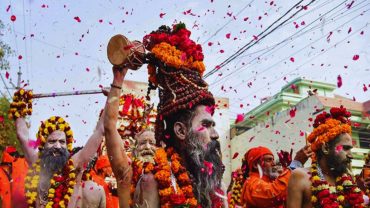Experience the spiritual dawn in Varanasi with Subah-e-Banaras, a mesmerizing ritual that unfolds on the sacred ghats. Immerse yourself in the ancient traditions, rituals, and the ethereal beauty of dawn on the Ganges, where spirituality and culture converge in a symphony of light and devotion

The Sacred Ganges at Dawn:
Varanasi, also known as Kashi, is synonymous with the Ganges, a river considered holy and purifying in Hinduism. Subah-e-Banaras begins on the ghats, the steps leading down to the river, where the faithful gather to partake in the age-old tradition of worship and cleansing. As the first light of day breaks, the Ganges comes alive with the hues of dawn, reflecting the city’s ancient history and spiritual significance.
Pilgrims and locals alike descend upon the ghats to perform ablutions, known as “Snan” in Hindi, cleansing themselves in the sacred waters. The rituals involve prayers, offerings, and the chanting of hymns, creating a harmonious symphony that resonates along the riverbanks.
Assi Ghat, one of the prominent ghats in Varanasi, is a focal point for Subah-e-Banaras. The serenity of the morning is complemented by the rhythmic sounds of the temple bells and the gentle lapping of the river against the ghats, setting the stage for a spiritual awakening.
Spiritual Practices at Dawn:
Subah-e-Banaras is not merely a visual spectacle; it is a deeply spiritual experience. The ghats become a canvas for a myriad of rituals, each imbued with profound meaning and devotion. Devotees engage in yoga and meditation, seeking a connection with the divine as the city awakens to a new day.
The practice of Surya Namaskar, salutations to the sun, takes on a special significance during Subah-e-Banaras. The rising sun symbolizes the dispelling of darkness, both literally and metaphorically, as participants pay homage to the life-giving force that sustains the universe.
Priests conduct elaborate ceremonies at the riverbanks, invoking blessings for the city and its inhabitants. The fragrance of incense mingles with the gentle breeze, creating an atmosphere where spirituality and nature converge.
Assi Ghat: The Epicenter of Subah-e-Banaras:

Assi Ghat, named after the Assi River that meets the Ganges at this point, is a pivotal location for Subah-e-Banaras. It is at this ghat that the confluence of tradition, culture, and spirituality is most palpable.
The morning aarti (ritual of worship) at Assi Ghat is a spectacle that captivates the soul. The rhythmic chanting, the synchronized movements of the priests, and the glow of countless oil lamps combine to create a divine ambiance. Pilgrims and spectators alike are drawn into the spiritual vortex, finding solace in the ancient rituals that unfold before them.
As the sun ascends, casting its golden glow on the river, Assi Ghat becomes a stage for cultural performances. Classical music, dance, and devotional songs resonate, adding a cultural dimension to the spiritual proceedings. Subah-e-Banaras, at Assi Ghat, is not just a religious ritual; it is a holistic celebration of life, art, and devotion.
Ganga Aarti: A Spectacle of Light and Devotion:

The pinnacle of Subah-e-Banaras is the Ganga Aarti, a grand ritualistic display of light and devotion. While the Ganga Aarti is more commonly associated with evening ceremonies, the morning rendition at Assi Ghat holds its own charm and significance.
The priests, clad in traditional attire, perform intricate rituals with meticulous precision. Brass lamps, laden with ghee and adorned with flowers, are lit in unison, creating a mesmerizing dance of light. The aarti is accompanied by the resonant sounds of conch shells, bells, and devotional songs, fostering an atmosphere of collective spirituality.
Witnessing the Ganga Aarti at dawn is a soul-stirring experience. The first light of day blends with the ethereal glow of the lamps, casting a divine radiance that transcends the material world. Devotees and onlookers offer their prayers, becoming part of a timeless tradition that has echoed through the ghats for generations.
Subah-e-Banaras Beyond Assi Ghat:
While Assi Ghat is a focal point, Subah-e-Banaras extends its embrace across the entire city. Other ghats, such as Dashashwamedh Ghat and Manikarnika Ghat, also witness devotees and pilgrims engaging in morning rituals. Each ghat adds its unique flavor to the spiritual symphony, contributing to the mosaic of Varanasi’s dawn.
Strolling through the labyrinthine lanes of Varanasi in the early hours reveals a city in transition. Temples open their doors, priests prepare for the day’s ceremonies, and the aroma of incense wafts through the air. The city, awakening from its nocturnal slumber, prepares to embrace the hustle and bustle that will characterize the rest of the day.
Cultural Heritage and Tourism:

Also read: Nepali Mandir
Subah-e-Banaras not only nurtures the spiritual soul of the city but also contributes significantly to its cultural heritage and tourism. Visitors from around the world are drawn to Varanasi to witness the ethereal beauty of dawn on the ghats and participate in the age-old rituals.
The city’s cultural calendar is enriched by Subah-e-Banaras, with festivals and events often aligning with the spiritual practices at dawn. This confluence of spirituality and culture creates a dynamic environment that resonates with both locals and tourists, fostering an exchange of ideas and experiences.
Preserving the Tradition:
While Varanasi evolves with the times, the essence of Subah-e-Banaras remains rooted in its ancient traditions. Efforts to preserve and promote this spiritual spectacle are essential for ensuring that future generations can continue to witness and partake in the city’s spiritual awakening.
Local initiatives, supported by the government and various organizations, focus on maintaining the cleanliness of the ghats, preserving historical structures, and promoting responsible tourism. These endeavors aim to safeguard the sanctity of Subah-e-Banaras while allowing it to flourish as a living tradition.
Also Read: Naimisharanya Mandir
Conclusion:
Subah-e-Banaras is not just a morning ritual; it is a symphony of spirituality, culture, and heritage that unfolds on the sacred ghats of Varanasi. As the city wakes to the gentle caress of dawn, the Ganges becomes a canvas painted with the hues of devotion, rituals, and the timeless connection between the earthly and the divine.
In the heart of Varanasi, Subah-e-Banaras invites everyone – pilgrim, resident, and traveler alike – to partake in the spiritual dance of a city that has been a cradle of civilization for centuries. In its ritualistic embrace, Subah-e-Banaras whispers the ancient truths of Varanasi, where each dawn is not just



Comment (0)